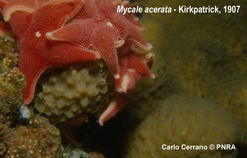

Mycale (Oxymycale) acerata Kirkpatrick, 1907
provided by British Antarctic Survey
Description
Mounds of Mycale acerata and the starfish that eat them are a common feature of hard bottom communities. Although it has no programmed shape (like many sponges) it tends to form mounds like those made by termites with many smooth rounded lobes protruding. Sometimes M acerata is the most common sponge and one of the most important contributors of biomass. This sponge is particularly notable for being one of the few sponges, or even any Antarctic invertebrates, that grows quickly. Despite this it still grows somewhat slower than the fastest growing temperate or tropical sponges. In periods of food shortage this species and some others may actually shrink over considerable periods of time. It is not known how long this sponge lives but it could probably be many decades.
7508 times added



Species distribution
Patagonia to Circum subantarctic and Antarctic waters
10m to deep waters
grows on hard rock ledges and cliffs
filters plankton from water column
There are no items on your guide yet!
Preview or











